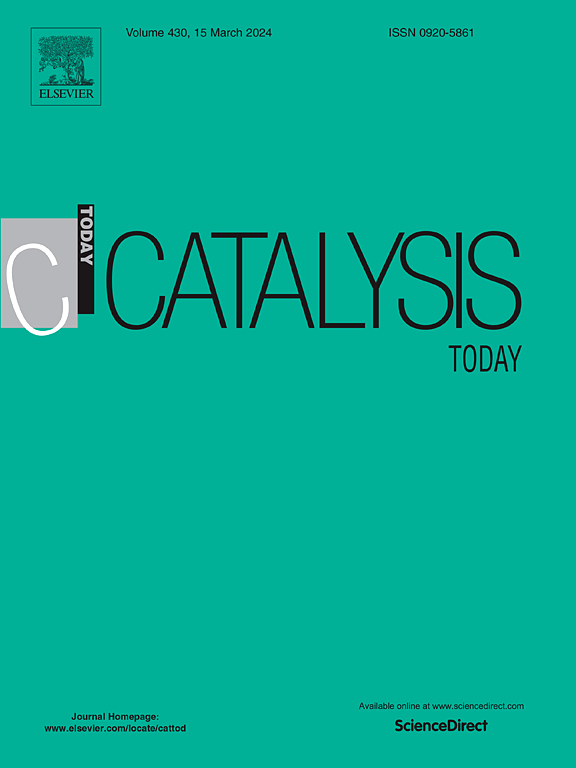Effect on tuning the CO2 hydrogenation to C5+ via co-impregnation: The Role of Cu and K distribution on Fe@TiO₂ catalysts
IF 5.2
2区 化学
Q1 CHEMISTRY, APPLIED
引用次数: 0
Abstract
Promoters play a crucial role in optimizing CO₂ hydrogenation by enhancing adsorption and lowering activation energy in heterogeneous catalysts. This study investigates the synergistic effects of potassium and copper on Fe@TiO₂ catalysts, focusing on their structural modification and influence over catalytic performance, mainly C5+ production. Characterization results demonstrated that K incorporation significantly increased weak basic sites, highlighting its dominant role as surface modification, enabling rapid CO₂ activation and desorption, preventing surface over-saturation, and facilitating CHx buildup and C–C coupling over Fe and Fe–Cu interfaces. Cu facilitated iron reducibility and CO formation via the RWGS reaction. The co-impregnation method led to a more homogeneous metal distribution, promoting uniform nucleation and minimizing phase segregation during drying and calcination, which improves catalyst stability and accessibility to active sites. Catalytic tests revealed that K10Fe@TiO₂, prepared by co-impregnation, exhibited the best performance with 20 % CO₂ conversion and 47 % selectivity toward C₂⁺ hydrocarbons while minimizing CH₄ formation (≤ 15 %). This preparation method enhanced the promoting effect of Cu in RWGS while optimizing K's role in chain growth via Fischer-Tropsch synthesis. These findings highlight the potential of co-impregnation to fine-tune Fe-based catalysts for selective CO₂ conversion, offering a promising pathway toward sustainable fuel production.
共浸渍对CO2加氢制C5+的影响:Cu和K分布在Fe@TiO₂催化剂上的作用
在非均相催化剂中,启动子通过增强吸附和降低活化能来优化CO 2加氢反应。本研究研究了钾和铜对Fe@TiO₂催化剂的协同作用,重点研究了它们的结构修饰和对催化性能的影响,主要是C5+的产生。表征结果表明,K掺入显著增加了弱碱性位点,突出了其在表面修饰中的主导作用,使CO 2快速活化和解吸,防止表面过饱和,促进CHx的积累和Fe和Fe - cu界面上的C-C耦合。Cu通过RWGS反应促进铁的还原性和CO的生成。共浸渍法使金属分布更加均匀,促进了干燥和煅烧过程中的成核均匀,减少了相偏析,从而提高了催化剂的稳定性和活性位点的可及性。催化实验表明,共浸渍法制备的K10Fe@TiO₂表现出最佳的性能,CO₂转化率为20% %,对C 2 +碳氢化合物的选择性为47 %,同时最小化了CH₄的生成(≤15 %)。该制备方法增强了Cu在RWGS中的促进作用,同时通过fisher - tropsch合成优化了K在RWGS链生长中的作用。这些发现突出了共浸渍技术在微调铁基催化剂选择性CO₂转化方面的潜力,为可持续燃料生产提供了一条有希望的途径。
本文章由计算机程序翻译,如有差异,请以英文原文为准。
求助全文
约1分钟内获得全文
求助全文
来源期刊

Catalysis Today
化学-工程:化工
CiteScore
11.50
自引率
3.80%
发文量
573
审稿时长
2.9 months
期刊介绍:
Catalysis Today focuses on the rapid publication of original invited papers devoted to currently important topics in catalysis and related subjects. The journal only publishes special issues (Proposing a Catalysis Today Special Issue), each of which is supervised by Guest Editors who recruit individual papers and oversee the peer review process. Catalysis Today offers researchers in the field of catalysis in-depth overviews of topical issues.
Both fundamental and applied aspects of catalysis are covered. Subjects such as catalysis of immobilized organometallic and biocatalytic systems are welcome. Subjects related to catalysis such as experimental techniques, adsorption, process technology, synthesis, in situ characterization, computational, theoretical modeling, imaging and others are included if there is a clear relationship to catalysis.
 求助内容:
求助内容: 应助结果提醒方式:
应助结果提醒方式:


